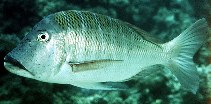個人による観察記録の追加 Fish Watcher
| Native range | All suitable habitat | Point map | Year 2050 |

|
| This map was computer-generated and has not yet been reviewed. |
| Lethrinus mahsena AquaMaps Data sources: GBIF OBIS |
Upload your 写真 and ビデオ
Pictures | グーグルの画像Lethrinus mahsena
Picture by Randall, J.E.
Pictures | グーグルの画像Lethrinus mahsena
Picture by Randall, J.E.
Egypt country information
Common names:
[No common name]
Occurrence: native
Salinity: marine
Abundance: | Ref:
Importance: commercial | Ref: Carpenter, K.E. and G.R. Allen, 1989
Aquaculture: | Ref:
Regulations: | Ref:
Uses: no uses
Comments:
National Checklist:
Country Information: https://www.cia.gov/library/publications/resources/the-world-factbook/geos/eg.html
National Fisheries Authority:
Occurrences: Occurrences Point map
Main Ref: Carpenter, K.E. and G.R. Allen, 1989
National Database:
Occurrence: native
Salinity: marine
Abundance: | Ref:
Importance: commercial | Ref: Carpenter, K.E. and G.R. Allen, 1989
Aquaculture: | Ref:
Regulations: | Ref:
Uses: no uses
Comments:
National Checklist:
Country Information: https://www.cia.gov/library/publications/resources/the-world-factbook/geos/eg.html
National Fisheries Authority:
Occurrences: Occurrences Point map
Main Ref: Carpenter, K.E. and G.R. Allen, 1989
National Database:
Common names from other countries
分類 / Names 共通名の | 類義語 | Catalog of Fishes(部類, 種) | ITIS | CoL | WoRMS | Cloffa
> Eupercaria/misc (Various families in series Eupercaria) > Lethrinidae (Emperors or scavengers) > Lethrininae
Etymology: Lethrinus: Greek, lethrinia, a fish pertaining to genus Pagellus.
Etymology: Lethrinus: Greek, lethrinia, a fish pertaining to genus Pagellus.
Environment: milieu / climate zone / depth range / distribution range 生態学
海 関連する礁; 移住性ではない; 深さの範囲 2 - 100 m (Ref. 9710). Tropical; 28°N - 26°S, 32°E - 82°E
分布 国々 | 国連食糧農業機関の区域 | エコシステム | 事件 | Point map | 導入 | Faunafri
Indian Ocean: Red Sea and East Africa to Sri Lanka. References to this species from the Central Pacific probably refer to Lethrinus atkinsoni.
Length at first maturity / サイズ / 重さ / 年齢
Maturity: Lm ?, range 19 - ? cm
Max length : 65.0 cm TL オス/雌雄の選別がない; (Ref. 2295); common length : 40.0 cm TL オス/雌雄の選別がない; (Ref. 2295); 最大記録サイズ: 27 年 (Ref. 42001)
Max length : 65.0 cm TL オス/雌雄の選別がない; (Ref. 2295); common length : 40.0 cm TL オス/雌雄の選別がない; (Ref. 2295); 最大記録サイズ: 27 年 (Ref. 42001)
簡単な記述 検索表 | 形態学 | 形態計測学
背面の脊椎 (合計) : 10; 背鰭 (合計) : 9; 肛門の骨: 3; 臀鰭: 8. Body color is yellow to greenish-blue, becoming lighter ventrally; usually with nine or ten dusky yellow-green or brown bars. The head is purplish gray, sometimes with a red blotch on the nape. A red bar is at the base of pectoral fin, sometimes extending broadly below and above the pectoral fin base to the edge of the operculum. The base of the upper and sometimes lower rays of pectoral fin is red. The base and tips of the pelvic fins are often red. The membranes of the dorsal fin is red (sometimes restricted to the base of the fins). The anal fin is whitish with the membranes between the forward rays often red. The caudal fin, especially the tips is reddish.
Found over reef areas and adjacent sandy and seagrass areas (Ref. 30573, 41878). Feeds mainly on echinoderms (most frequently sea urchins), crustaceans and fishes; mollusks, tunicates, sponges, polychaetes and other worms are consumed in lesser quantities. A protogynous hermaphrodite (Ref. 55367). In most areas of the Red Sea, it is considered an excellent food fish but in certain areas of the Indian Ocean it may have an unpleasant 'coral' smell and taste (Ref. 2295, 11888). Utilized fresh for broiling and baking (Ref. 9987).
Life cycle and mating behavior 成熟 | 繁殖 | 放精 | 卵 | 生産力 | 幼生
Sex change was found to commonly occur between the ages of 5 and 6 years (Ref. 2295). A diandric species (Ref. 55367). Length and age at sex change occur at 32 cm TL and 16 yrs, respectively (Ref. 55367).
主な参考文献
Upload your references | 参考文献 | コーディネーター | 協力者
Carpenter, K.E. and G.R. Allen, 1989. FAO Species Catalogue. Vol. 9. Emperor fishes and large-eye breams of the world (family Lethrinidae). An annotated and illustrated catalogue of lethrinid species known to date. FAO Fish. Synop. 125(9):118 p. Rome: FAO. (Ref. 2295)
人間に対する脅威
Harmless
Human uses
水産業: 高い商業の; ゲームフィッシュ: はい
FAO(水産業: 代謝; publication : search) | FishSource | 私達の周りの海
より多くの情報
Population dynamics
成長のパラメーター
Max. ages / sizes
Length-weight rel.
Length-length rel.
体長組成
Mass conversion
補充
豊度
成長のパラメーター
Max. ages / sizes
Length-weight rel.
Length-length rel.
体長組成
Mass conversion
補充
豊度
Physiology
Body composition
Nutrients
酸素消費
水泳形態
泳ぐ速さ
Visual pigments
Fish sound
Diseases & Parasites
Toxicity (LC50s)
Body composition
Nutrients
酸素消費
水泳形態
泳ぐ速さ
Visual pigments
Fish sound
Diseases & Parasites
Toxicity (LC50s)
Genetics
遺伝子の
Heterozygosity
遺伝
遺伝子の
Heterozygosity
遺伝
用具
Bio-Quiz | E-book | 野外観察図鑑 | Length-frequency wizard | 生活史の基盤ツール | 目的のマップ | Classification Tree
| Catch-MSY |
特記事項
XMLをダウンロードして下さい
インターネットの情報源
Aquatic Commons | BHL | Cloffa | BOLDSystems | Websites from users | Check FishWatcher | CISTI | Catalog of Fishes(部類, 種) | DiscoverLife | ECOTOX | Faunafri | Fishtrace | GenBank(ゲノム, ヌクレオチド) | GloBI | GOBASE | | Google Books | Google Scholar | Google | IGFA World Record | MitoFish | 国のデーターベース | Otolith Atlas of Taiwan Fishes | PubMed | Reef Life Survey | Scirus | SeaLifeBase | 生命の木 | Wikipedia(行く, 検索する) | World Records Freshwater Fishing | 動物に関する記録
Estimates based on models
Preferred temperature (Ref. 115969): 25.4 - 29.2, mean 27.5 (based on 406 cells).
Phylogenetic diversity index (Ref. 82804): PD50 = 0.5000 [Uniqueness, from 0.5 = low to 2.0 = high].
Bayesian length-weight: a=0.01349 (0.00840 - 0.02167), b=3.02 (2.89 - 3.15), in cm Total Length, based on LWR estimates for this species & Genus-body shape (Ref. 93245).
栄養段階 (Ref. 69278): 3.8 ±0.33 se; based on food items.
回復力 (Ref. 120179): 手段, 1.4年~4.4年の倍増期間の最小個体群 (K=0.10-0.30; tm=3; tmax=27; Fec=26,700).
Prior r = 0.50, 95% CL = 0.33 - 0.75, Based on 3 data-limited stock assessments.
Fishing Vulnerability (Ref. 59153): High vulnerability (65 of 100).
Climate Vulnerability (Ref. 125649): High to very high vulnerability (73 of 100).




